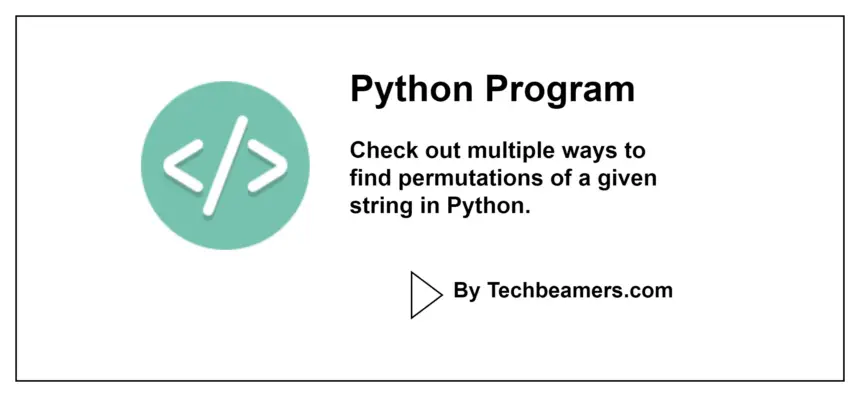Welcome to the exciting world of permutations! In this tutorial, we won’t just cover the basics of finding all possible permutations of a string in Python. We’ll show you not just one, two, or even three, but four unique ways to solve this problem!
But why stop at just the solutions? We’ll also delve into the logic behind finding permutations. Understanding the process is key to becoming a successful problem-solver.
Permutations are a common problem in computer science and can be applied to a variety of tasks. From searching for anagrams to generating all possible combinations of a set of elements, the possibilities are endless.
And with Python, we can accomplish this task in multiple ways. So get ready to explore the different methods for finding string permutations in Python. This blog is your ultimate guide to becoming a master problem-solver!
Ways to Find All Possible Permutations of a String
1. Using itertools to find string permutations
In Python, you can find string permutations by using the itertools library’s permutations() function. The permutations() function generates all possible permutations of a given string, with a specified length.
To use the permutations() function, you need to first import the itertools library.
Below is the Python code using the permutations() function to find the permutations of a given string:
import itertools
string = "Python"
permutations = list(itertools.permutations(string))
for count, perm in enumerate(permutations):
print(''.join(perm), end=" ")
print()
print("Total no. of permutations done: ", count+1)
In the above example, we first import the itertools library. We then define a string, “Python,” for which we want to find the permutations. We use the permutations() function to generate all possible permutations of the string and store the result in a list. Finally, we print the list of permutations. Note that the permutations() function returns an iterator object, so we convert it to a list before printing.
2. Using recursion to find the permutation of a string
In Python, you can also find string permutations by implementing a recursive algorithm. The idea behind this algorithm is to find all permutations of a given string by recursively swapping each character in the string with all the characters that come after it.
Here is the sample code implementing a recursive function to find permutations of a given string in Python:
permute_count = 0
def find_str_permutation(string, left, right):
global permute_count
if left == right:
print(''.join(string), end=" ")
permute_count += 1
else:
for i in range(left, right + 1):
string[left], string[i] = string[i], string[left]
find_str_permutation(string, left + 1, right)
string[left], string[i] = string[i], string[left]
string = "Python"
n = len(string)
string = list(string)
find_str_permutation(string, 0, n-1)
print()
print("Total no. of permutations done: ", permute_count)
In the above example, we define a recursive function, find_str_permutation(), that takes in three arguments: the input string, the left index of the string, and the right index. We first check if the left index is equal to the right index, which means that we have reached the end of the string and have found a permutation. If so, we print the permutation. Otherwise, we loop through each character in the string, swapping the left character with the current character, and recursively calling the find_str_permutation() function on the remaining substring. We then swap the characters back to their original position before continuing to the next iteration of the loop. Finally, we convert the input string to a list and call the find_str_permutation() function with the appropriate parameters to find all permutations of the string.
3. Using a recursive backtracking algorithm
In Python, you can find string permutations by using a recursive backtracking algorithm. The idea behind this algorithm is to generate all possible permutations by trying all possible combinations of characters at each position.
Here is an example of how to implement a recursive backtracking function to find permutations of a given string in Python:
permute_count = 0
def backtracking_func(string, perm, used):
global permute_count
if len(perm) == len(string):
print(''.join(perm), end=" ")
permute_count += 1
else:
for i in range(len(string)):
if not used[i]:
used[i] = True
perm.append(string[i])
backtracking_func(string, perm, used)
used[i] = False
perm.pop()
string = "Python"
used = [False] * len(string)
backtracking_func(string, [], used)
print()
print("Total no. of permutations done: ", permute_count)
In the above example, we define a recursive function, backtracking_func(), that takes in three arguments: the input string, a list to store the current permutation, and a list to keep track of which characters have already been used in the permutation. We first check if the length of the current permutation is equal to the length of the input string, which means that we have found a permutation. If so, we print the permutation. Otherwise, we loop through each character in the string and check if it has already been used in the permutation. If not, we add the character to the permutation, mark it as used, and recursively call the backtracking_func() function on the remaining characters. Once we have found all permutations that start with the current character, we backtrack by removing the last character from the permutation and marking it as unused before continuing to the next iteration of the loop. Finally, we call the backtracking_func() function with an empty permutation and a list of unused characters to find all permutations of the string.
4. Using the heap method to find string permutations in Python
In Python, you can find string permutations by using the Heap algorithm. The Heap algorithm is a recursive algorithm that generates all possible permutations of a given string by swapping characters and generating all permutations for the remaining substring.
Here is an example of how to implement the Heap algorithm to find permutations of a given string in Python:
permute_count = 0
def heap_permute(string, size):
global permute_count
if size == 1:
print(''.join(string), end =" ")
permute_count += 1
else:
for i in range(size):
heap_permute(string, size-1)
if size % 2 == 1:
string[0], string[size-1] = string[size-1], string[0]
else:
string[i], string[size-1] = string[size-1], string[i]
string = "abcd"
n = len(string)
string = list(string)
heap_permute(string, n)
print()
print("Total no. of permutations done: ", permute_count)
In the above example, we define a recursive function, heap_permute(), that takes in two arguments: the input string and the size of the string. We first check if the size of the string is equal to 1, which means that we have found a permutation. If so, we print the permutation. Otherwise, we loop through each character in the string, generate all permutations for the remaining substring, and swap the first and last characters of the substring. We continue to swap the first and last characters of the substring until all possible permutations have been generated. Finally, we convert the input string to a list and call the heap_permute() function with the appropriate parameters to find all permutations of the string.
Wrapping Up
Congratulations, you’ve now unlocked the power of finding string permutations in Python! We hope you enjoyed learning about the various methods we covered.
But don’t stop here! Our website is filled with popular tutorials that are definitely worth checking out. Whether you’re a beginner or an experienced programmer, we have something for everyone.
- Python Heapq (With Examples)
- Generate Floating Point Range in Python
- Python Program to Generate a Fibonacci Sequence Using Recursion
- Python Glob Module – Glob() Method
- A Beginners Guide to Become a Machine Learning Engineer
At Techbeamers, we’re committed to helping you become a better programmer. We believe that knowledge should be shared and accessible to everyone. That’s why we strive to create easy-to-follow tutorials that are both informative and engaging.
So thank you for choosing Techbeamers as your learning resource. We hope to see you again soon for more exciting tutorials!








